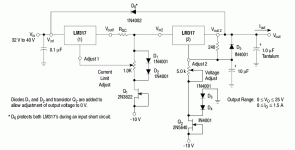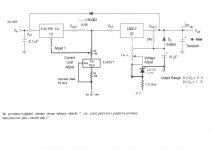Initial load regulation is 0.1%. If you add 0.33 ohm in the output, this will be degraded to more than 10% for a 5V output. I don't think a degradation by a factor 100 is negligible.@Elvee you seem to enjoy contradicting me just for the fun of it...
ANY decent regulator includes this resistor in the feedback loop, making it completely transparent. That is the case with the LM338 for example.ANY active current limiting would imply a shunt resistor and so a voltage drop on it, but it is small enough so you are not worryed, and for the life of me i cannot understand what is souch a BIG issue few tens of volts drop? the author did not mention the exact purpose of the supply, but as i sayd mV preccision and preccision current limmiting is not likely to happen with thys tipe of regulator.
Are you talking about me?MarianB there are Trolls on all the forums. Just ignore them.
That is sheer madness: adding a second excessive regulator because the first one is already oversized.Page 14 confirms what I originally posted.
Using the right part in the first place is much more effective and simpler than all these half-baked solutions
It's sad to see the lenght some people would go just to get the last word, just to be the ones that are right... it is verry dissapointing to see that in stead of trying to really help the ones in need, some people prefere to just dissagree with other, just for the fun of it, hell yeah, we are waaaay better than the others why should we bother beying civilised? our role should alway be to cast aside anyone stranger to our grup no matter what the reason, even if that means looking for a needle in a hay stack, sooner or later we will find a hole on he's boath and so a good enough reason to just hunt him down no matter what...
Sad, and dissapointing... i had wanted to show something way better than anything you can do with this tipe of regs, much more precise, but as i see some people can never be satisfied cus they do not want to... why bother? it is obvious something wrong will be found in anything i say so the hell with it...
All the best wishez too all of you, even to you @Elvee, honest
Sad, and dissapointing... i had wanted to show something way better than anything you can do with this tipe of regs, much more precise, but as i see some people can never be satisfied cus they do not want to... why bother? it is obvious something wrong will be found in anything i say so the hell with it...
All the best wishez too all of you, even to you @Elvee, honest
I judge technical propositions purely on their technical merits.It's sad to see the lenght some people would go just to get the last word, just to be the ones that are right... it is verry dissapointing ..
....
...much more precise, but as i see some people can never be satisfied cus they do not want to... why bother? it is obvious something wrong will be found in anything i say so the hell with it...
All the best wishez too all of you, even to you @Elvee, honest
I think that's all the OP is interested in.
If you want to make it a personnality issue, that's your responsability only.
Anyone opposed to just installing a panel ammeter?
Engineering is often a study in compromise (OK, maybe not so much with engineers) and the OP has been given a plethora of options. I suppose he can pick his poison.
thanks sofaspud and everyone else. at this moment i'm not sure exactly which route i will take but between everyone's posts i've got quite a number of possible solutions.
@dietnews there are litteraly loads and loads of ways to go, linear or switching, you first have to make sure what you need the most, what you want the unit to be used for, do you need preccision voltage regulation, preccision current limmiting, low ripple and/or noise line... make up your mind exactly what you want and what compromise you would be able to make, then it will be werry easy to choose the way to go.
The circuit posted on #10 has all that's needed, both high precision voltage source and safe current limiting, just a couple parts need to be moved around.
But no need to add extra regulators or switch chip type.
I would actually move only one...
An other advantage with it is that you can also use the R3 as the shunt for an ammeter! Which is nice...
Didn't thougt of it but yes it woud work just fine that way..you can also use the R3 as the shunt for an ammeter! Which is nice...
Depends on the meaning of "precision" and "safe": in this case, a worst case error of 50%, and a current that can reach ~4A.high precision voltage source and safe current limiting,.
There is also the unresolved issue of loop stability in the current limit mode.
That worst case scenario of voltage regulation less precission would be at the minimum Vout/max Iout, i doubt this unit will power something that sensitive... for real performance lab power supply a much more powerfull transformer is rerquired along with much more complex regs... this unit i think it is just good enough for general testing. As for that 4A, that will only be at shorted output, witch u do not seam to get it that this circuit is not intended, a 2A fuse along with this circuit will make sure nothing bad will happen with it, the regulator will be able to witstand the stress for those few seconds untill the fuse blows up as for the power transformer, well, if a 50/60Hz transformer blows up at the first shorted output then the hell with it, it's not wort anything.
So thing is either you do not see, don't want too see that you are just looking for problems where they are not... as i sayd, this cind of behaviour it is sad...
So thing is either you do not see, don't want too see that you are just looking for problems where they are not... as i sayd, this cind of behaviour it is sad...
Depends on the meaning of "precision" and "safe": in this case, a worst case error of 50%, and a current that can reach ~4A.
There is also the unresolved issue of loop stability in the current limit mode.
You have no idea.
"Precision" refers to the built-in precision of the regulator.
Just check the datasheet.
Does it state 0.1% or whatever? Well, that's what you'll get.
50% error?
Not even an unregulated supply will be that bad
Current can reach 4A ?
Who says so?
Didn't I tell you the OP can current limit it to *any* value he wants?
Loop stability in the current limit?
Don't worry about that , all these regulators are *designed* to be able to be current limited.
No designer worth his salt will release an unstable design.
By the way, palstanturhin *instantly* understood what I am talking about.
And he also thought about another practical use, go figure.
No doubt many others did too.
Think a little and you will too
- Status
- This old topic is closed. If you want to reopen this topic, contact a moderator using the "Report Post" button.
- Home
- Amplifiers
- Power Supplies
- adding current limiting to a power supply

